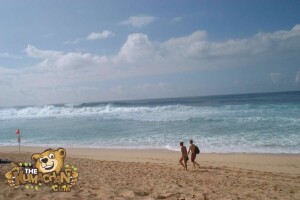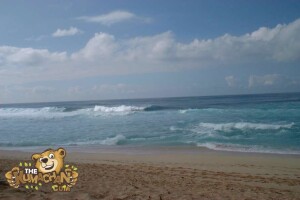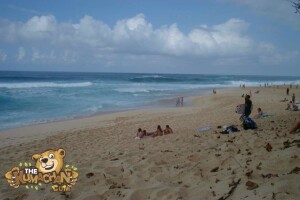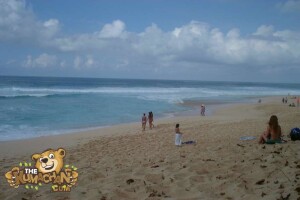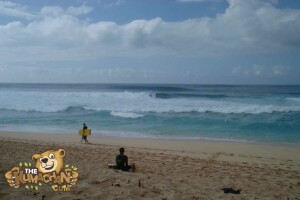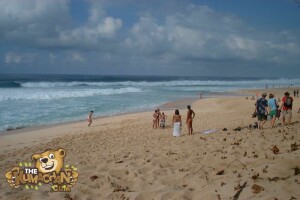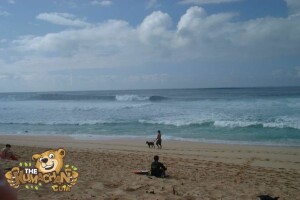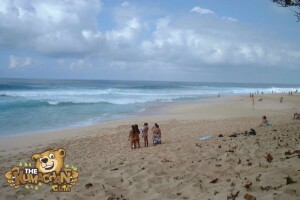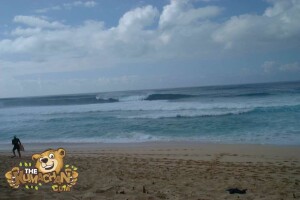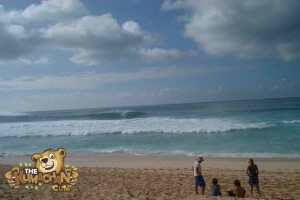There are certain places in this world that feel less like a destination and more like a living legend, a myth carved into geography and memory, a place where human ambition meets raw, unrelenting nature. The Banzai Pipeline on the North Shore of Oʻahu is one of those places. If you surf, it’s Mecca. If you don’t, it’s still Mecca — only instead of a pilgrimage on a board, it’s a pilgrimage of sight and sound, a chance to stand in awe as the ocean folds itself into perfection and chaos at the same time. I’d heard the waves were going to be especially good, the kind of swell that locals whisper about and photographers dream of. So I did what anyone who’s ever fallen under the spell of the North Shore does: I got in the car, rolled down the windows to let the salt-heavy breeze rush in, and drove out to snap some photos of the surf at the Pipeline. I knew it would be beautiful. I didn’t know it would feel like standing inside the heartbeat of the ocean itself.
The drive out always sets the stage. Leaving the city behind, the air changes, the landscape softens, and by the time you’re threading through the winding roads past pineapple fields, it’s as if you’re entering another world. The North Shore is slower, older, more rooted. Roadside stands selling coconuts and plate lunches, hitchhikers with boards tucked under their arms, the sight of pickup trucks with sandy footprints stamped into their beds — it all signals that you’re approaching a stretch of coast where time bends around the tides. As I got closer to Ehukai Beach Park, where the Pipeline unfurls its power, I could feel a familiar pull, that sense of anticipation like walking toward a stadium before a big game. Only here, the stadium was the Pacific Ocean, and the game was played on waves the size of two-story houses.
When I first saw the sets rolling in, my breath caught in my throat. Pipeline isn’t just a wave — it’s a force of nature sculpted into artistry. Imagine water rising, curling, and then collapsing with the precision of a collapsing cathedral dome, the lip of the wave thick as a concrete wall, the barrel hollow enough to fit a small car. The sound alone is enough to freeze you in place: a thunderclap of water meeting reef, over and over, a pulse you feel in your chest more than hear with your ears. It’s terrifying and intoxicating all at once. Standing on that sand, camera in hand, I felt like a child watching giants dance, powerless but ecstatic just to be in the presence of something so much bigger than myself.
The surfers who paddle out at Pipeline are not like the rest of us. They’re gladiators. Watching them, you realize this isn’t about fun in the sun. This is about testing yourself against the most dangerous, most perfect wave on the planet. These surfers are calculating risks at every second: when to paddle, when to pop up, when to tuck into the barrel and pray the ocean lets them out the other side. Some make it, gliding through tubes of emerald light, emerging like champions to the roar of the beach. Others don’t. I watched one surfer get eaten alive by a closing wave, his board snapping in half like a toothpick, his body disappearing beneath the foam. For a moment, everyone on shore held their breath, eyes locked on the spot where he vanished. And then, finally, he surfaced, gasping, dragging himself toward shore. The crowd exhaled. Applause broke out, not just for surviving, but for daring to try.
As I snapped photos, I realized the Pipeline isn’t just about surfers and waves — it’s about community. The beach was alive with energy: locals sprawled on towels with coolers of poke and beer, tourists craning their necks to capture phone videos, old-timers telling stories of the days when Gerry Lopez first carved his legend here, when wipeouts seemed even wilder and the boards were far less forgiving. Photographers lined the sand with lenses as long as baseball bats, each hoping to catch the perfect shot of a surfer disappearing into a barrel of liquid glass. There were families with kids building sandcastles just feet from the ocean’s fury, and there were wide-eyed travelers like me, soaking it all in, feeling the mix of fear and awe that Pipeline always inspires.
There’s something humbling about trying to capture Pipeline in photos. You can point your lens, adjust your settings, and freeze a moment, but the essence of the place refuses to be tamed. No photograph can replicate the way the air tastes of salt and spray, the way your skin feels sticky with mist after just minutes on the shore, the way your heart skips when you see a surfer commit to a drop that looks impossible. Still, I kept shooting, chasing fragments of the truth. A surfer crouched low, swallowed by a barrel of turquoise. Another thrown skyward as the wave detonated beneath him. Spray exploding like fireworks into the sunlight. Each click of the shutter felt like an offering, a small way of honoring the giants roaring before me.
Pipeline is a paradox: it’s heaven for surfers and hell for the unprepared. Beneath that beauty lies a reef sharp enough to shred skin, shallow enough to break bones. Every ride is a gamble, every wave a test of courage. And yet, that’s why it matters. Pipeline doesn’t just hand out glory; it demands respect, punishes arrogance, and rewards those who balance skill with humility. Watching it, you realize that life is the same. The biggest rewards come when you paddle into fear, when you risk being swallowed whole for the chance to dance with something greater than yourself.
As the day wore on, the light shifted, the waves glowing gold under the late afternoon sun. Surfers kept charging, silhouettes against the horizon, some triumphant, some humbled. The crowd thinned a little, but I couldn’t leave. I kept shooting, kept watching, kept listening to the thunder of water folding over reef. It was hypnotic, almost spiritual. Standing there, I understood why people dedicate their lives to this place, why surfers travel across the world just for one ride at Pipeline, why legends are born and lost here. It isn’t just a wave. It’s a living story, an eternal reminder that the ocean will always be bigger, stronger, and wilder than we are — and that’s exactly why we love it.
Driving back that evening, windows down, the North Shore fading in the rearview, I felt changed. Pipeline had once again reminded me of what it means to witness greatness, not the human kind alone but the natural kind, the kind that makes you stop and say, “This is it. This is why we’re alive.” The photos on my camera were souvenirs, but the real memory was deeper: the sound, the sight, the awe, the humility. I knew I’d be back. Because once you’ve stood on the sand at Pipeline, once you’ve watched the giants roar, once you’ve felt your own heartbeat sync with the rhythm of the surf, you never really leave.

